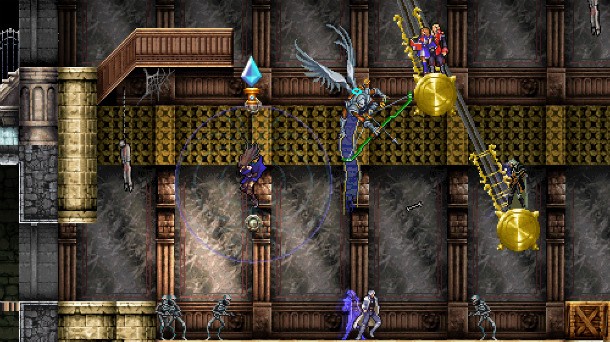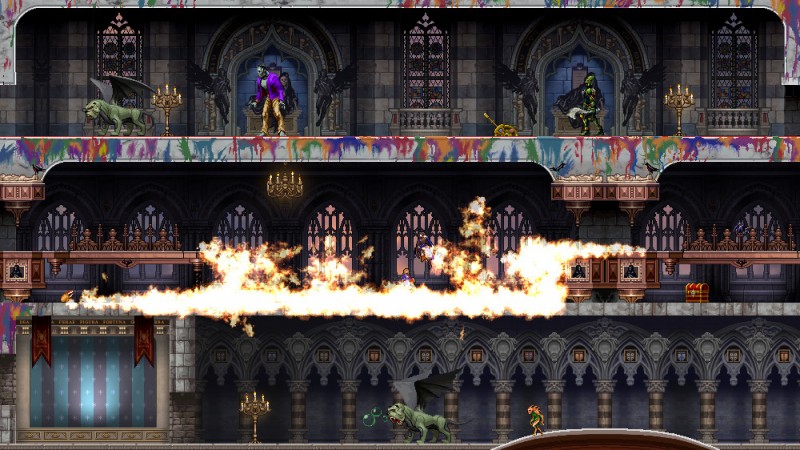Our extra-large special edition is here. Subscribe today and receive the 25% longer issue at no extra cost!
Castlevania: Harmony Of Despair Hands-On Impressions

Igarashi and crew are crafting a brand new entry in their classic franchise exclusively for XBLA, and we took the game for a test drive.
Harmony of Despair is set up as a classic 2D sidescroller, but the structure of the gameplay is an entirely new approach for the franchise. The game can be played single-player, but its real innovation comes in the form of six-player simultaneous cooperative online play.
As the game starts, players are offered a choice between several familiar faces from the Castlevania canon. We saw Alucard, Soma Cruz, Jonathan Harris, Shanoa, and Charlotte, although it's entirely possible that there are other vampire hunters yet to be revealed by Konami. Each of the different characters has unique strengths, weaknesses, and abilities.
Once in the game, the initial layout looks very like any of the recent DS Castlevania games, but there's a surprising number of things that are different after some investigation. First, the game is divided into levels rather than one large dungeon. We saw Chapter 1, entitled "Caught in the Cradle of Decay". These large multi-pathed levels have lots of rooms and variety to them, but each individual level is smaller than the sprawling maps of previous games in the series. These smaller levels are meant to be tackled in a short time frame. Players navigate through the level as fast as they can (a timer counts down your remaining minutes and seconds) and gather treasure on the way to the level's boss. Players can stick together throughout the climb to the end, or separate out and help each other in less direct ways. As you tackle these encounters, the game includes a scaling difficulty curve that responds to the number of players in the game.

We played as Shanoa in one sequence as Alucard ran along nearby. One of Shanoa's powers let her ascend to a ledge that Alucard couldn't reach, so we left our co-op partner behind and continued alone. Eventually, we came to a lever, but pulling it didn't affect anything in our path. However, in a chamber far below, a door opened for Alucard.
These cooperative challenges seem to be characteristic of the level design in Harmony of Despair, with lots of interweaving paths through the level -- each of which lead to level completion. However, along the way players will find treasure. These treasures can be restorative items, new weapons or armor, or money. No matter the reward, every partner shares in the windfall. Even if only one of the characters finds the hidden chest, everyone receives some variation of the reward.
A fascinating feature replaces the familiar mapping mechanic that has been a hallmark of the series for years. Players will commonly play in the first of three views -- a close-up action view that exactly emulates earlier games. A second panned out view gives a wider view of the action, and helps players to prepare for threats far across the room, or get a view of a location further away. The third view is a full level view at an extremely distant viewing angle. The entire level is visible to the player in this view, but unlike a map, this is a real-time, playable view. Players can see all the monsters moving around the level, the location of their allies and their actions, and can control their own actions as well. It's a fascinating way to get the big picture of the situation before zooming back in for some real fighting. Moving about the level, you'll occasionally encounter large books. These sites allow you to enter your inventory and change your equipment, adjusting between the many weapon types that pop up throughout the game.

The levels are clearly inspired by earlier games in the series, and we saw lots of familiar enemies along the way to the boss. Leaping along swinging clock pendulums, whipping at advancing skeletal warriors, and ducking beneath passing fireballs, the gameplay feels familiar and as tight as any Castlevania.
We also learned of a competitive survival mode, wherein each character aims to take out the others. Unfortunately, this mode, along with other cooperative levels, remain to be seen. Nonetheless, this newly announced XBLA title looks like a fascinating departure for the well-loved series, even as it remains rooted in the gameplay that has sustained it for years.

Get the Game Informer Print Edition!
Explore your favorite games in premium print format, delivered to your door.
- 10 issues per year
- Only $4.80 per issue
- Full digital magazine archive access
- Since 1991








